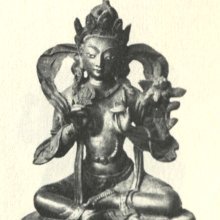Viryaparamita, Vīryapāramitā, Virya-paramita: 6 definitions
Introduction:
Viryaparamita means something in Buddhism, Pali, Hinduism, Sanskrit. If you want to know the exact meaning, history, etymology or English translation of this term then check out the descriptions on this page. Add your comment or reference to a book if you want to contribute to this summary article.
Images (photo gallery)
In Buddhism
Mahayana (major branch of Buddhism)
Source: Wisdom Library: Maha Prajnaparamita SastraVīryapāramitā (वीर्यपारमिता) refers to the “virtue of exertion” and represents one of the six perfections (pāramitā). How does the Bodhisattva fulfill the virtue of exertion (vīryapāramitā)? Answer: When he possesses great exertion of mind. Thus the Bodhisattva Mahātyāgavat, putting his life at the disposal of all his friends, swore to empty the water of the ocean until it was completely dry, and his resolve was firm. Here again, the Bodhisattva praised the Buddha Puṣya for seven days and seven nights standing on one leg without blinking his eyes.
Source: academia.edu: A Study and Translation of the GaganagañjaparipṛcchāVīryapāramitā (वीर्यपारमिता) refers to the “perfection of vigour”, according to the Gaganagañjaparipṛcchā: the eighth chapter of the Mahāsaṃnipāta (a collection of Mahāyāna Buddhist Sūtras).—Accordingly, “How then, son of good family, does the Bodhisattva collect all qualities of the Buddha by thorough practice (yoniśas-prayoga)? [...] The vigour (vīrya) is the cause of collecting all Buddha learning; The Bodhisattva makes an effort, attains all roots of good (kuśalamūla), transfers the vigour of attaining all roots of good into omniscience, and fulfils the perfection of vigour (vīryapāramitā). [...]”.

Mahayana (महायान, mahāyāna) is a major branch of Buddhism focusing on the path of a Bodhisattva (spiritual aspirants/ enlightened beings). Extant literature is vast and primarely composed in the Sanskrit language. There are many sūtras of which some of the earliest are the various Prajñāpāramitā sūtras.
Tibetan Buddhism (Vajrayana or tantric Buddhism)
Source: archive.org: The Indian Buddhist IconographyVīryapāramitā (वीर्यपारमिता) refers to one of twelve Pāramitā Goddesses in human form, as commonly depicted in Buddhist Iconography, and mentioned in the 11th-century Niṣpannayogāvalī of Mahāpaṇḍita Abhayākara.—Her Colour is green; her Symbol is a blue lotus; she has two arms.
Vīryapāramitā is described in the Niṣpannayogāvalī (dharmadhātuvāgīśvara-maṇḍala) as follows:—
“Vīryapāramitā is of the colour of emerald and holds in her left hand the blue lotus”.
[She holds the cintāmaṇi banner as usual. A statue of this deity is found in China.
The twelve deities collectively have their spiritual father in Ratnasambhava. [...] According to a statement in the maṇḍala all the deities [viz., Vīryapāramitā] are two-armed, and they hold in the right hand the flag marked with the Cintāmaṇi jewel, and in the left their special symbols. Prajñāpāramitā is an exception since she has two more hands.]

Tibetan Buddhism includes schools such as Nyingma, Kadampa, Kagyu and Gelug. Their primary canon of literature is divided in two broad categories: The Kangyur, which consists of Buddha’s words, and the Tengyur, which includes commentaries from various sources. Esotericism and tantra techniques (vajrayāna) are collected indepently.
General definition (in Buddhism)
Source: Wisdom Library: Dharma-samgrahaVīryapāramitā (वीर्यपारमिता) or simply vīrya refers to the “perfection of energy” and represents the fourth of the “six perferctions” (ṣaṭpāramitā) as defined in the Dharma-saṃgraha (section 17). The Dharma-samgraha (Dharmasangraha) is an extensive glossary of Buddhist technical terms in Sanskrit (e.g., ṣaṣ-pāramitā and vīrya-pāramitā). The work is attributed to Nagarjuna who lived around the 2nd century A.D.
Vīryapāramitā forms, besides a part of the “six perferctions” (ṣaṭpāramitā), also a part of the “ten perfections” (daśa-pāramitā).
Languages of India and abroad
Sanskrit dictionary
Source: Cologne Digital Sanskrit Dictionaries: Monier-Williams Sanskrit-English DictionaryVīryapāramitā (वीर्यपारमिता):—[=vīrya-pāramitā] [from vīrya > vīr] f. (with Buddhists) highest degree of fortitude or energy (one of the 6 perfections), [Kāraṇḍa-vyūha; Dharmasaṃgraha 17] ([Monier-Williams’ Buddhism 128]).
[Sanskrit to German]
Sanskrit, also spelled संस्कृतम् (saṃskṛtam), is an ancient language of India commonly seen as the grandmother of the Indo-European language family (even English!). Closely allied with Prakrit and Pali, Sanskrit is more exhaustive in both grammar and terms and has the most extensive collection of literature in the world, greatly surpassing its sister-languages Greek and Latin.
See also (Relevant definitions)
Partial matches: Virya, Paramita.
Full-text: Shatparamita, Samvardhaka, Six Perfections, Paramita, Dashaparamita, Ten Perfections, Virya.
Relevant text
Search found 10 books and stories containing Viryaparamita, Vīryapāramitā, Virya-paramita, Vīrya-pāramitā; (plurals include: Viryaparamitas, Vīryapāramitās, paramitas, pāramitās). You can also click to the full overview containing English textual excerpts. Below are direct links for the most relevant articles:
Maha Prajnaparamita Sastra (by Gelongma Karma Migme Chödrön)
Part 2 - Practicing the six perfections < [Chapter XLV - Application of Merit]
4. Generosity and the virtue of exertion < [Part 14 - Generosity and the other virtues]
Part 2 - The method of non-dwelling < [Chapter XVII - The Virtue of Generosity]
Vimalakirti Nirdesa Sutra (by Charles Luk)
Ksitigarbha Bodhisattva fundamental vow sutra (by Johnny Yu)
Prajnaparamita in Buddhist < [November-December 1931]
Vimalakīrti Sutra (by John R. McRae)
Chapter IV - Bodhisattvas < [Fascicle One]
Mahayana Mahaparinirvana Sutra
Chapter XXII - On Pure Actions (b) < [Section Four]
Chapter XX - On Holy Actions (b) < [Section Three]

